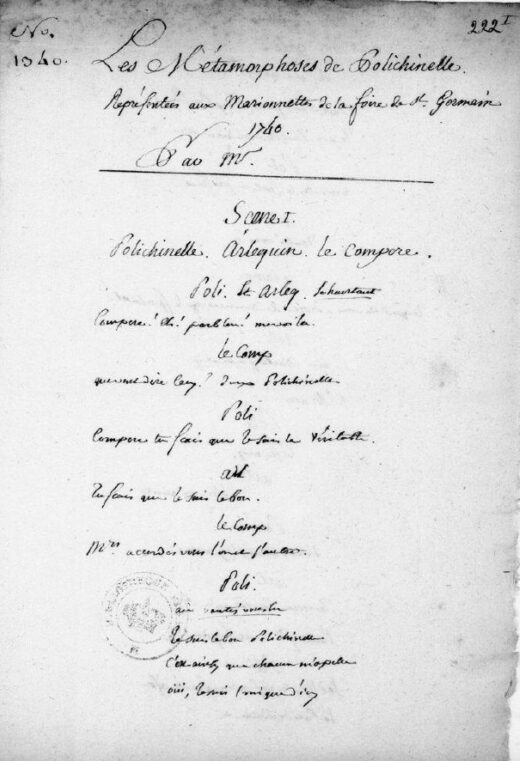
Printed
16 pages
Les Métamorphoses de Polichinelle
This anonymous play is known thanks to a manuscript of the Soleinne collection (Bibliothèque nationale de France, Ms Fr 9313). Françoise Rubellin, who published the text, suggests that it was written by Fuzelier, who had started writing plays for puppets in the same year—1740.
The comic of the first scenes is based on dual identities: two Polichinelles are shown. Then, the play builds “with drawers” – that is, several characters follow one another and all ask, as Polichinelle does, to be changed into Arlequin. This play is a response to Les Métamorphoses d’Arlequin (Arlequin’s Metamorphoses), an anonymous play performed at the Comédie-Italienne in December 1739; in it, the actor playing Arlequin (Antonio Costantini) dressed as Polichinelle.
Several characters transform into Arlequin
The Compère (Stooge) is surprised when he sees two Polichinelle walk onto the stage: one of them is Arlequin dressed as Polichinelle, and the two quarrel. Alone, Polichinelle then asks the benevolent Fée (Fairy) to change him into Arlequin. She also gives him the power to transform anyone he wants into Arlequin. Several characters come to him: a Marchand (male Merchant) who wants to go to a ball to make sure that his wife is not being unfaithful to him; the female peasant Margot, who wants to become rich; an Ivrogne (Drunkard) who believes that he is at the Comédie-Italienne; and a Danseuse (female Dancer).
First performance
Foire Saint-Germain, Bienfait's box
Publications and translations
Françoise Rubellin (dir.), Marionnettes du XVIIIe siècle, Anthologie de textes rares. Montpellier: Espaces 34, 2022: 203-313.